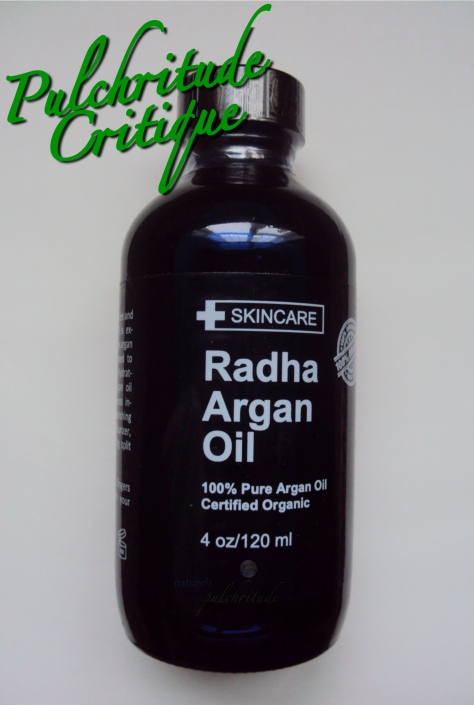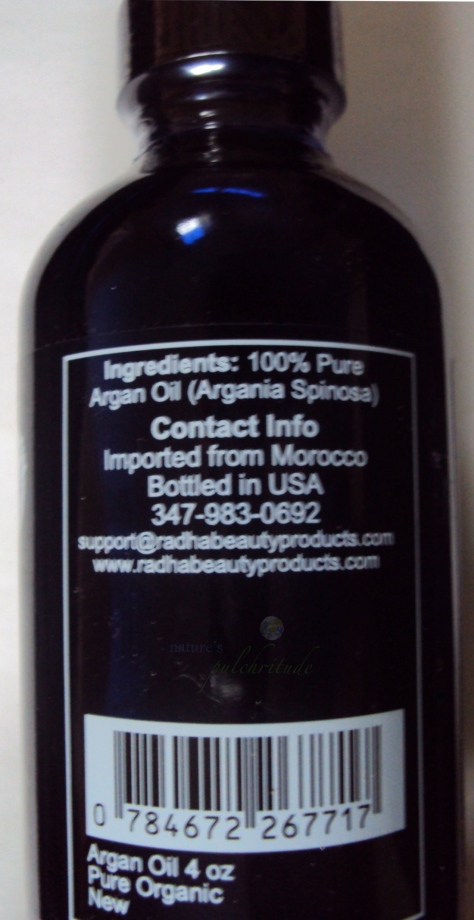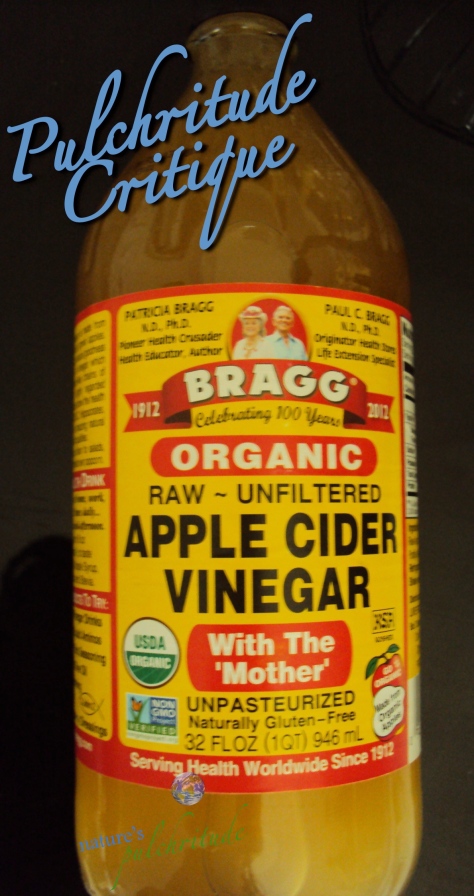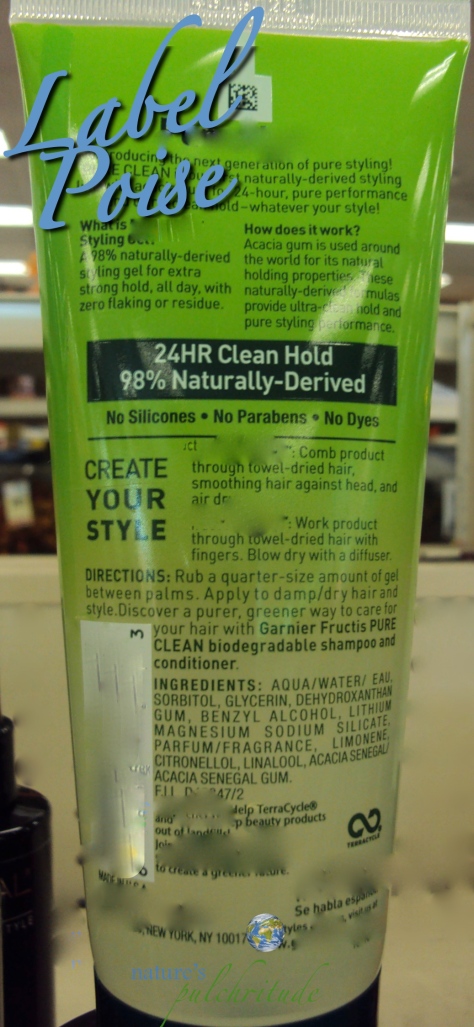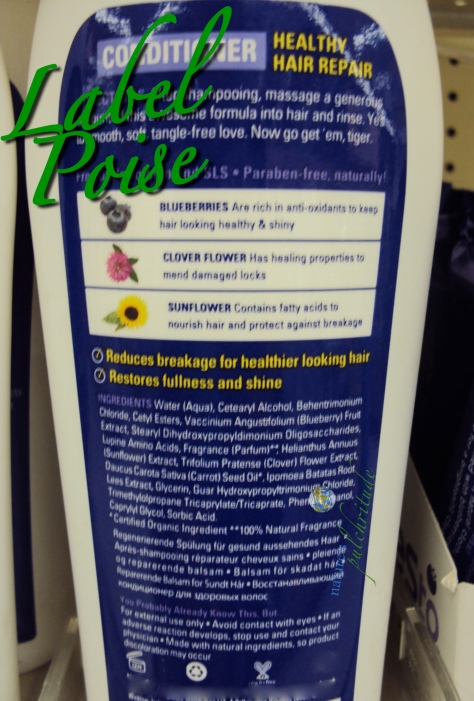A friend highly recommended a hair conditioner to you and you are in your local drugstore to purchase it. You get excited when you see so many great ingredients on the list and are so glad this product was recommended to you. Is this product as great as you think? Remember, I am teaching you Label Poise–how to walk the walk, talk the talk, and buy products that meet YOUR standards, whether natural, organic, or safe enough. For instructions on Label Poise visit our Label Poise page.
The Label
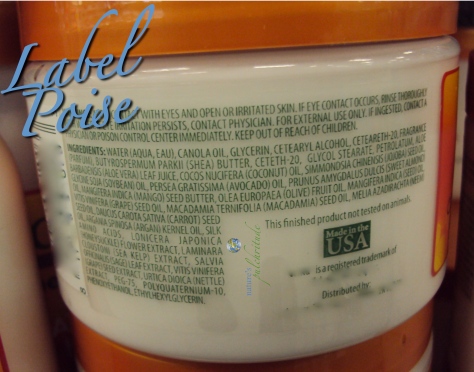
The Ingredients
Water: Safe! Water is the ultimate moisturizer and is a key ingredient in many moisturizing products.
Canola Oil: Safe!/Beware! This ingredient is derived from the rapeseed and is used as an emollient and skin conditioning agent. This ingredient can also be genetically modified and contaminated with pesticides as an estimated 87% of all canola grown in the US was genetically modified in 2005.
Glycerin: Safe! Glycerin is a humectant that attracts moisture in the skin. Glycerine can be derived from fats and oils, or synthetically–which is not indicated here. (MSDS)
Cetearyl Alcohol: Safe! Typically naturally derived from Coconut and Palm Oils (though it can be derived synthetically), it is a mixture of Cetyl and Stearyl fatty alcohols. This ingredient acts as a thickener and moisturizer in personal care products. In pure form, this ingredient can be a slight skin irritant and permeator, and is toxic to mucous membranes. The is no data available on human toxicity, carcinogenicity, mutagenicity, developmental toxicity, and teratogenicity. (MSDS)
Ceteareth-20: Beware! A derivative of Cetearyl Alcohol (Cetyl and Stearyl Alcohol) and Ethylene Oxide (a known carcinogen), this ingredient is used as an emulsifier and emollient. Ceteareth-20 is a penetration enhancer that can allow other (potentially) hazardous substances to enter your system. This ingredient may also be contaminated with 1,4-dioxane, a known carcinogen, as well as Ethylene Oxide. Carcinogen contamination depends largely on how well purified the chemical is. Products with this ingredient should not be applied to damaged skin as it may result in kidney damage. In pure form it can be a skin, eye, and respiratory irritant, however there is no information on carcinogenicity, teratogenicity, mutagenicity, or developmental toxicity. (MSDS; MSDS)
Fragrance (Parfum): Beware! Fragrances are often synthetic. Though they are low in concentration in the product, there is still a small chance of having an allergic reaction.
Butyrospermum Parkii (Shea) Butter: Safe! This ingredient is derived from the nut of the Shea Tree and is used for its moisturizing properties. (MSDS)
Ceteth-20: Safe!/Beware! This ingredient is a polyethylene glycol ether of Cetyl Alcohol and is used as a surfactant and emulsifying agent. This ingredient can be a skin and eye ingredient in pure form, though there is limited toxicological information available. It is not known to be a carcinogen, however, polyethylene glycol can be contaminated with ethylene oxide and 1,4-dioxane–a suspected and known carcinogen, respectively. (MSDS;MSDS)
Glycol Stearate: Beware! Also known as glycol monostearate, glycol stearate is an ester of stearic acid and ethylene glycol, a known human toxin. It is primarily used as a opacifier (opaque, non transparent) and pearling agent and acts as an emulfisfier. In 2001, Glycol Stearol was used in hair conditioners in concentrations of 0.0001-3%. It is presently suggested for use in concentrations between 2-10% by weight of the formula, depending on the purpose in the product. Given it is an ester of ethylene glycol it may be contaminated with carcinogen 1,4-dioxane. It is not known to be a skin irritant up to 50%, based on patch tests, though it may be a mild eye irritant in pure form. It is not listed as a carcinogen, there is no data on mutagenicity. (MSDS; MSDS)
Petrolatum: Beware! This ingredient is also known as Petroleum Jelly is a hydrocarbon and is a distillate of crude (oil). It is used in skin lotions as an emollient and to prevent skin moisture loss. Similar to mineral oil, it prevents moisture from entering or leaving the barrier. There is no information on carcinogenicity, teratogenicity, mutagenicity, or developmental toxicity. Unless it is guaranteed 100% refined, petroleum may be with carcinogens. It can be a potential skin, eye, digestive, and lung irritant. (MSDS)
Aloe Barbadensis (Aloe Vera) Leaf Juice: Safe! This ingredient is used for its nutrient content and moisturizing properties.
Cocos Nucifera (Coconut) Oil: Safe! Coconut oil is used for is skin conditioning and moisturizing properties. It is high in vitamins E and K.
Simmondsia Chinensis (Jojoba) Seed Oil: Safe! This ‘oil’ is a liquid wax and has a moderate fatty acid content.
Glycine Soja (Soybean) Oil: Safe!/Avoid! Soybean oil is used as an emollient and emulsifier. Produced from soy beans, this oil may be genetically modified, contaminated with pesticides, and thus contain a lower linolenic acid content. A source of origin would clarify this. Other than GMO and pesticide contaminate, soybean oil is not known to be toxic or carcinogenic.
Persea Gratissima (Avocado) Oil: Safe! This oil contains Vitamin E and contains antioxidants.
Prunus Amygdalus Dulcis (Sweet Almond) Oil: Safe! Sweet Almond oil is high in oleic acid and is primarily used as an emollient.
Mangifera Indica (Mango) Seed Butter: Safe! This ingredient is made from the seed of a mango and is known for its moisturizing properties.
Olea Europaea (Olive) Fruit Oil: Safe! Olive oil is used for its skin conditioning and anti-inflammatory properties. It is rich in vitamins E and A, as well as antioxidants. (MSDS)
Mangifera Indica (Seed) Oil: Safe! Mango oil is extracted from the seed of a mango, and is the oil fraction obtained from producing mango butter. It is high in stearic and oleic acids.
Vitis Vinifera (Grape) Seed Oil: Safe! Grapeseed oil is high in linoleic acid and is high in beneficial antioxidants.
Macadamia Ternifolia (Macadamia) Seed Oil: Safe! This ingredient is made by pressing macadamia nuts and is used for its moisturizing and emollient properties. If you are allergic to tree nuts or macadamia nuts, Beware!
Melia Azadirachta (Neem) Oil: Safe! This oil is pressed from the fruit and seed of Neem, which is a tree native to India. It is high in oleic acid and is known for its moisturizing properties. It is used for a variety of purposes in traditional Ayurveda.
Daucus Carota Sativa (Carrot) Seed Oil: Safe! Carrot seed oil is used as an emollient and skin conditioning agent. It is high in omega 3 fatty acids, antioxidants, and nutrients such as Beta Carotene, vitamin A and Stigmasterol. It is not known to be toxic, an irritant, or sensitizer. (MSDS ; MSDS)
Argana Spinosa (Argan) Kernel Oil: Safe! This oil is made from the kernels of the argan tree found in Morocco. It is high in oleic and linoleic fatty acids and is renowned for its hair repairing and moisturizing properties. (MSDS)
Silk Amino Acids: Safe! Silk amino acids are water soluble glycoproteins extracted from raw silk. It is high in serine and aids in moisture retention. Silk amino acids are producing by hydrolyzing silk proteins into smaller peptide chains of 18 to 19 amino acids. This ingredient has a high molecular weight and therefore does not absorb into the skin. It can be an eye irritant in pure form, though it is not known to be carcinogenic. (MSDS;MSDS)
Lonicera Japonica (Japanese Honeysuckle) Flower Extract: Beware! This ingredient is used in conjunction with Honeysuckle extract as a preservative. It is not known to be toxic or an irritant in small quantities. It should be noted that parabens are very similar in structure (essentially the synthetic version) to p-hydrobenzoic acid, the active ingredient in Japanese Honeysuckle extract. It is believed to act similarly to parabens in the body. (MSDS)
Laminata Cloustoni (Sea Kelp) Extract: Safe!/Beware! [Editor’s Note: The scientific name of this ingredient is actually Brown Algae.] This ingredient is used as a skin protectant and fragrance ingredient. No MSDS Found.
Salvis Officinalis (Sage) Leaf Extract: Safe! This ingredient is used as a skin conditioning agent, skin protectant, and antioxidant. It is generally regarded as safe and is not known to be toxic. (MSDS; MSDS)
Vitis Vinifera (Grape) Seed Extract: Safe! Grape seed Extract is high in vitamin E, flavonoids, linoleic acid, and phenolic procyanidins. It is used in cosmetics because of its believed antibacterial properties, and is thus used as a preservative. Grape seed extract is also used for its antioxidant properties as well as believed astringent and restoring properties. It is typically used in cosmetic forumlations between 5-10% of the formula. It can be an eye, skin, and lung irritant in pure form, though it is not known to be carcinogenic. (MSDS;MSDS)
Urtica Dioica (Nettle) Extract: Safe! This ingredient is used for its conditioning and astringent properties. Depending on the concentration Avoid! if you have high blood pressure as it is believed to increase circulation. (MSDS)
PEG-75: Beware!/Avoid! This ingredient is a polymer of polyethlene glycol and has a molecular weight of 4000. This ingredient is used as a binder, humectant, and solvent. No MSDS Found.
Polyquarternium-10: Beware! This ingredient is a polymeric quaternary ammonium salt of hydroyethyly-cellulose and is used as an anti-static agent and film former. Polyquaternium-10 readily bonds to hair proteins and increases viscosity (thickness) of the conditioner. It is typically used in concentrations between 0.2% – 2%. At greater concentrations it can cause skin irritation. No data available on carcinogenicity or mutagenicity. It is not believed to be genotoxic. I would not use this product unless you chemically relax or treat your hair. (MSDS)
Phenoxyethanol: Beware!/Avoid! This is a preservative. You will notice it is very high on the list of ingredients. It is used because it is safer than formaldehyde-releasing preservatives, though the FDA released a warning about how it can impact the central nervous system and induce vomiting in infants. It is also suspected to be a xenoestrogen (mimics estrogen), a cause of contact dermatitis and skin irritant. In pure form phenoxyethanol is toxic to kidneys, the nervous system, and liver; it is an extremely hazardous eye irritant and a very hazardous eye irritant, though information on carcinogenicity, mutagenicity, teratogenicity, and developmental toxicity are not available. It is banned in the EU and Japan in concentrations over 1%. Therefore, one would assume it is either greater than the EU concentration restraint or it is in accordance, and the remaining ingredients in this product are at very low concentrations. This ingredient is made from 2 carcinogens (benzene and ethylene oxide), though it itself is not known to be carcinogenic. People around small children should ‘Avoid!‘ this ingredient, others should ‘Beware!‘. (MSDS)
Ethylhexylglycerin: Beware! This ingredient is a glyceryl ether and is the condensation product of 2-ethylhexanol and glycerin. This ingredient is typically derived from vegetable oil, but goes through various chemical transformations before becoming the final product. It is used as a skin conditioning agent, deodorizer, and very mild preservative. It is typically used in concentrations of 0.0003 – 2% by weight of a formula. Though it is used in the treatment of eczema, it is believed to be a skin, eye, and lung irritant. It is not known to be carcinogenic, a reproductive, developmental toxin, or genotoxin. No Individual MSDS. (CIR Report; MSDS: Caprylyl Glycol & Ethylhexylglycerin).
Nature’s Pulchritude’s Verdict: This product has A LOT of great ingredients in it. It does not have any parabens or -isothiazoline preservatives. Only problem with this product is all of those great ingredients come after both fragrance and petrolatum. The first 5 ingredients in this conditioner are fairly good. Canola oil is not a high quality oil and likely does not have the same effect on the hair as some of the other oils lower down on the list. Fragrance being so high on the lists leads me to believe the ‘better’ ingredients in this product are low in quantity and may not have a significant impact on the hair. I would try this product if it didn’t have petrolatum in it, though as is, it may be a great option for you or a friend!






